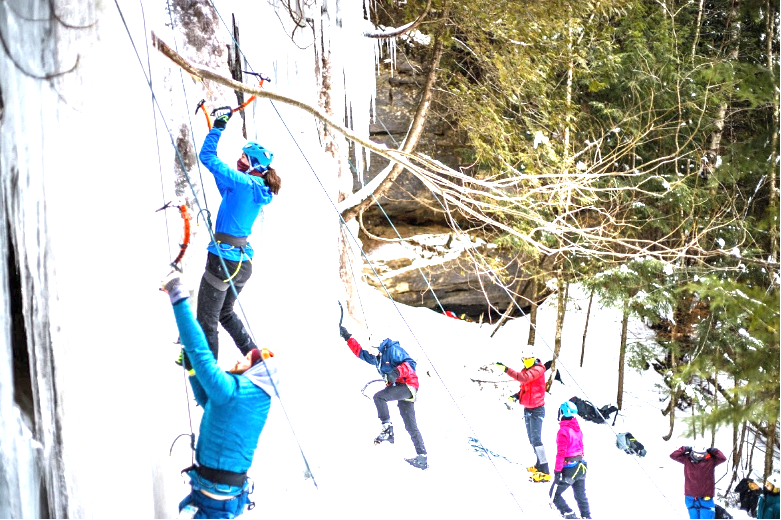As winter rages on and temperatures drop into the single digits, students may find it harder and harder to get outside and be active. But the students in RE253 Introduction to Ice Climbing take the cold in stride. In mid-January, 16 NMU students completed the one credit, one weekend course for ice climbing.
Students are expected to participate, be active, and hike and carry their stuff to where they’ll climb, but the course was doable, said one of the students, Katharina Springhetti, a senior majoring in sports science.
“Last semester, I took rock climbing,” said Springhetti. “My instructors told me if you’re interested in ice climbing, you should take the course this semester.”
Being a swimmer for NMU, the ice course helped Springhetti stay active and was a good alternative to swimming, she said.
“Doing different types of sports helps you get better in other sports,” said Springhetti.
The ice climbing course, which is offered twice in the winter semester, is a beginner’s course teaching students the basics of ice climbing as part of the School of Health and Human Performance, said sports science major coordinator and instructor for the course, Scott Drum, who has been at NMU since 2012. The course will be offered again from March 5 through 7.
“If students are curious, they should try it, even if it’s just out of curiosity,” said Drum. “The course is ‘top rope’, meaning students can enjoy the use of equipment but don’t have to lead or set up ropes. All equipment is provided … we provide the boots, crampons, harness, helmet and ice axes as well.”
The course is three days long, but the first day is usually a three to four hour session on a Friday afternoon to talk about how to layer outdoor clothing, use the equipment and a little bit of how-to on ice climbing. The next two days are 7 a.m. to 5 p.m. at Pictured Rocks National Lakeshore in Munising, according to Drum.
“As part of the first day, we check out gear to them, through the recreation department,” said Drum. “So they get to take home and fiddle with the equipment.”
The course usually has around 12 students and two guides are needed. This segment had 16 students and three guides to help out, said Drum.
“Some years we have alumni that come back, that became really good climbers, even guides,” said Drum.
The class promotes a healthy, active lifestyle that students can add to their outdoor activity list. They hike into the ice forms they will climb, and while climbing, they have the ice axes in their hands and crampons on their feet. Use of the entire body is needed for ice climbing. It is somewhat like a full body contact sport, according to Drum.
The unknown this year was COVID-19, but it turned out not to be a big deal, said Drum. The students wore masks in the classroom and were able to be physically distanced, he added.
“The pandemic lightly hung over the class,” said Drum. “Kids were more relaxed this far into the pandemic.”
Many students have seen ice and frozen waterfalls, but a lot are stunned that water seeps from the sandstone to create large vertical ice forms on the rocks, which amazes many students, said Drum.
“The look on their faces is always priceless. The students are fish-out-of-the-water their first time, but improve by the second or third climb,” said Drum
There are well over 200 different named ice climbs around Pictured Rocks. The class was taken by a lot of students that Springhetti knew, so being in an unfamiliar environment made it easier to enjoy the course, she said. Despite the chilly temperatures, the students were still able to enjoy being outside, according to Springhetti.
For more information about the course visit the course description.

























